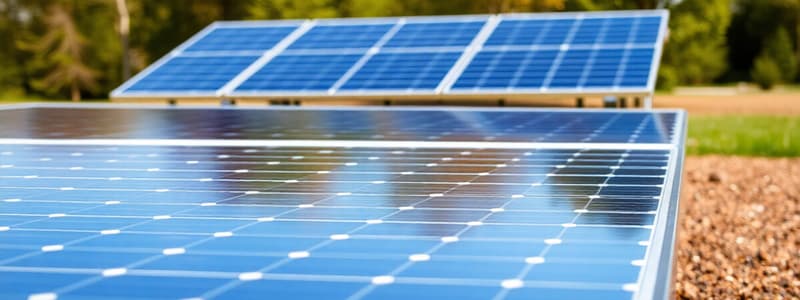Podcast
Questions and Answers
What module cost range is associated with perovskite/CIS technologies?
What module cost range is associated with perovskite/CIS technologies?
- 0.30 to 0.35 USD$/W
- 0.49 to 0.55 USD$/W
- 0.40 to 0.48 USD$/W
- 0.36 to 0.44 USD$/W (correct)
Which technology is likely to have a higher module cost when manufactured in Europe or the USA?
Which technology is likely to have a higher module cost when manufactured in Europe or the USA?
- Perovskite/CIS technologies
- Flexible solar panels
- Thin-film tandems
- Perovskite/HJT tandems (correct)
Which of the following factors directly influences the module cost fraction of perovskite/silicon tandems?
Which of the following factors directly influences the module cost fraction of perovskite/silicon tandems?
- Market share of PERC technology (correct)
- The efficiency of silicon cells
- Average lifespan of the modules
- Geographical location of manufacturing
What is the probability of perovskite/CIS manufactured in the EU having a lower MSP than perovskite/PERC manufactured in China?
What is the probability of perovskite/CIS manufactured in the EU having a lower MSP than perovskite/PERC manufactured in China?
What approach is taken to account for expected PCE improvements?
What approach is taken to account for expected PCE improvements?
Which of the following is a likely outcome for perovskite tandem technologies manufactured in the USA?
Which of the following is a likely outcome for perovskite tandem technologies manufactured in the USA?
What is the estimated MSP for perovskite/HJT technologies?
What is the estimated MSP for perovskite/HJT technologies?
What market condition affects the module cost fraction dependent on perovskite technology?
What market condition affects the module cost fraction dependent on perovskite technology?
What is the main goal of the paper regarding PV systems?
What is the main goal of the paper regarding PV systems?
Which PV technology is excluded from consideration in this study despite being a potential alternative?
Which PV technology is excluded from consideration in this study despite being a potential alternative?
What factors are compared in Figures 5 and 6 of the paper?
What factors are compared in Figures 5 and 6 of the paper?
What does LCOE stand for in the context of PV systems?
What does LCOE stand for in the context of PV systems?
What implication is made regarding China's silicon PV production?
What implication is made regarding China's silicon PV production?
What is a key comparison made regarding perovskite/CIS tandem technology?
What is a key comparison made regarding perovskite/CIS tandem technology?
What aspect of PV systems is primarily influenced by cell degradation rates as shown in Figure 4?
What aspect of PV systems is primarily influenced by cell degradation rates as shown in Figure 4?
What scale of manufacturing capacity is referenced for comparison in the study?
What scale of manufacturing capacity is referenced for comparison in the study?
What does the IEA 2022 special report focus on?
What does the IEA 2022 special report focus on?
Which organization provided data on international trade in green energy products in 2022?
Which organization provided data on international trade in green energy products in 2022?
What does the 2021 annual solar photovoltaic module shipments report by EIA detail?
What does the 2021 annual solar photovoltaic module shipments report by EIA detail?
According to the content, which report discusses renewable power generation costs in 2021?
According to the content, which report discusses renewable power generation costs in 2021?
What key issue is highlighted by Goldthau and Hughes in their Nature article?
What key issue is highlighted by Goldthau and Hughes in their Nature article?
In what year was the OECD economic outlook interim report published?
In what year was the OECD economic outlook interim report published?
What trend in imports and exports of green energy products does Eurostat highlight?
What trend in imports and exports of green energy products does Eurostat highlight?
What does the IEA Energy Technology Perspectives 2023 report address?
What does the IEA Energy Technology Perspectives 2023 report address?
What are thin-film tandem technologies expected to provide in the market?
What are thin-film tandem technologies expected to provide in the market?
Which type of PV is indicated as the typical candidate for market deployment?
Which type of PV is indicated as the typical candidate for market deployment?
What assumption is necessary for thin-film tandems to be considered cost-competitive?
What assumption is necessary for thin-film tandems to be considered cost-competitive?
Which advantage do thin-film tandems offer compared to silicon tandems?
Which advantage do thin-film tandems offer compared to silicon tandems?
What is a limitation mentioned regarding the study on tandem PV technologies?
What is a limitation mentioned regarding the study on tandem PV technologies?
How do perovskite/CIS tandems manufactured in the EU compare to PERC SJ in terms of manufacturing capacity?
How do perovskite/CIS tandems manufactured in the EU compare to PERC SJ in terms of manufacturing capacity?
What is indicated regarding project costs and emissions for thin-film tandems?
What is indicated regarding project costs and emissions for thin-film tandems?
What does the projected LCOE and GEF data represent?
What does the projected LCOE and GEF data represent?
What is the purpose of the energy yield (EY) analysis in this study?
What is the purpose of the energy yield (EY) analysis in this study?
Which module is NOT part of the EYcalc platform used for energy yield estimation?
Which module is NOT part of the EYcalc platform used for energy yield estimation?
What kind of losses are considered in the initial outcomes of the energy yield simulations?
What kind of losses are considered in the initial outcomes of the energy yield simulations?
What data is used to calculate a solar spectrum for each hour of the year?
What data is used to calculate a solar spectrum for each hour of the year?
Which factor is NOT included in the meteorological data for the locations assessed?
Which factor is NOT included in the meteorological data for the locations assessed?
What technique is used to describe light absorption properties of the layers in the solar cell stack?
What technique is used to describe light absorption properties of the layers in the solar cell stack?
Which of the following parameters is NOT considered when determining irradiation conditions?
Which of the following parameters is NOT considered when determining irradiation conditions?
Why are temperature differences not considered across various locations in the energy yield calculations?
Why are temperature differences not considered across various locations in the energy yield calculations?
What is the assumed future efficiency increase for specific tandem technologies?
What is the assumed future efficiency increase for specific tandem technologies?
Which tandem technologies have been noted for competitive LCOE and GHG emission reductions?
Which tandem technologies have been noted for competitive LCOE and GHG emission reductions?
What does LCOE stand for in the context of photovoltaic systems?
What does LCOE stand for in the context of photovoltaic systems?
How do perovskite/CIS tandems manufactured in the EU compare to PERC SJ tandems made in China?
How do perovskite/CIS tandems manufactured in the EU compare to PERC SJ tandems made in China?
Which aspect is highlighted as a limitation in the current analysis?
Which aspect is highlighted as a limitation in the current analysis?
What trend is anticipated for thin-film PV production in the EU and the USA by 2050?
What trend is anticipated for thin-film PV production in the EU and the USA by 2050?
Which of the following describes future research possibilities suggested in the content?
Which of the following describes future research possibilities suggested in the content?
Which technology is mentioned as having the potential for higher learning rates affecting economic metrics?
Which technology is mentioned as having the potential for higher learning rates affecting economic metrics?
Flashcards
Module Cost Estimation
Module Cost Estimation
A method of estimating the cost of a solar module based on its efficiency (PCE) and other factors, such as manufacturing location and market share.
Perovskite/Silicon Tandem
Perovskite/Silicon Tandem
A type of solar cell where a thin layer of perovskite material is placed on top of a silicon base.
Perovskite/Silicon Tandem
Perovskite/Silicon Tandem
A solar module manufacturing technique utilizing a combination of perovskite and crystalline silicon materials, leading to high efficiency and potential cost reductions.
Manufacturing Selling Price (MSP)
Manufacturing Selling Price (MSP)
Signup and view all the flashcards
Perovskite/CIS Tandem
Perovskite/CIS Tandem
Signup and view all the flashcards
Market Share
Market Share
Signup and view all the flashcards
Logistic Function
Logistic Function
Signup and view all the flashcards
Photoconversion Efficiency (PCE)
Photoconversion Efficiency (PCE)
Signup and view all the flashcards
Energy Yield (EY)
Energy Yield (EY)
Signup and view all the flashcards
EYcalc
EYcalc
Signup and view all the flashcards
Irradiance Module
Irradiance Module
Signup and view all the flashcards
Optics Module
Optics Module
Signup and view all the flashcards
Transfer-Matrix Method (TMM)
Transfer-Matrix Method (TMM)
Signup and view all the flashcards
Lambert-Beer Law
Lambert-Beer Law
Signup and view all the flashcards
TMY3 Data (Typical Meteorological Year data)
TMY3 Data (Typical Meteorological Year data)
Signup and view all the flashcards
Power Conversion Efficiency (PCE)
Power Conversion Efficiency (PCE)
Signup and view all the flashcards
Thin-Film Tandem
Thin-Film Tandem
Signup and view all the flashcards
Perovskite/Silicon Tandem Cell
Perovskite/Silicon Tandem Cell
Signup and view all the flashcards
Levelized Cost of Electricity (LCOE)
Levelized Cost of Electricity (LCOE)
Signup and view all the flashcards
Global Energy Footprint (GEF)
Global Energy Footprint (GEF)
Signup and view all the flashcards
Perovskite Cell Degradation Rate
Perovskite Cell Degradation Rate
Signup and view all the flashcards
PERC Silicon (SJ) Photovoltaics (PVs)
PERC Silicon (SJ) Photovoltaics (PVs)
Signup and view all the flashcards
LCOE Comparison
LCOE Comparison
Signup and view all the flashcards
Supply Chain Diversification
Supply Chain Diversification
Signup and view all the flashcards
Decarbonization
Decarbonization
Signup and view all the flashcards
Photovoltaic Conversion Efficiency (PCE)
Photovoltaic Conversion Efficiency (PCE)
Signup and view all the flashcards
GHG Emission Reduction
GHG Emission Reduction
Signup and view all the flashcards
Learning Rate
Learning Rate
Signup and view all the flashcards
Tandem Solar Cell
Tandem Solar Cell
Signup and view all the flashcards
Perovskite/HJT Tandem
Perovskite/HJT Tandem
Signup and view all the flashcards
Study Notes
Introduction
- Global photovoltaic (PV) capacity is expected to exceed 40 TW by 2050
- Silicon-based single-junction (SJ) solar modules account for 95% of the current PV market
- China dominates PV manufacturing, holding over 75% of production capacity
- PV module prices have decreased by over 80% in the last decade, primarily due to Chinese production
- Global supply chains are vulnerable to disruptions, with reliance on China posing risks
Methods
- The study assesses the cost-competitiveness and greenhouse gas (GHG) emissions of various PV technologies
- Thin-film tandem PV technologies are evaluated, particularly perovskite/CIGS
- Current and future costs and GHG emissions are calculated for different production locations (China, USA, EU) at residential and utility scales
- The study covers manufacturing from the material acquisition to the final production (cradle-to-gate)
- Energy yield is considered, considering factors such as climate conditions in three locations (Phoenix, Miami, Seattle)
Results
- Thin-film tandem technologies show potential cost competitiveness with single-junction silicon technologies, especially in the EU and USA
- EU and USA-manufactured thin-film tandems have slightly higher costs per kWh but significantly lower GHG emissions per kWh compared to China-manufactured SJ technologies
- Perovskite solar cells are expected to compete with lower MSPs due to lower manufacturing costs
- GHG emissions associated with EU and USA manufacture are significantly lower than those associated with Chinese manufacture
- Tandems with perovskite or other thin-film technologies have better cost per kWh and reduce GHG emissions compared to standard silicon technologies
Studying That Suits You
Use AI to generate personalized quizzes and flashcards to suit your learning preferences.




